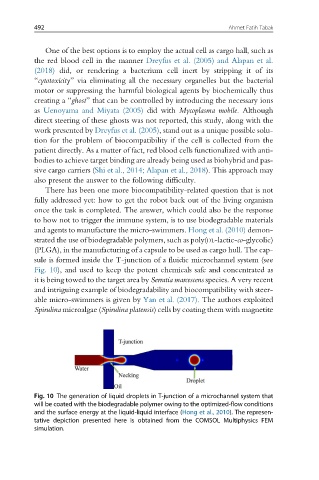Page 498 - Handbook of Biomechatronics
P. 498
492 Ahmet Fatih Tabak
One of the best options is to employ the actual cell as cargo hall, such as
the red blood cell in the manner Dreyfus et al. (2005) and Alapan et al.
(2018) did, or rendering a bacterium cell inert by stripping it of its
“cytotoxicity” via eliminating all the necessary organelles but the bacterial
motor or suppressing the harmful biological agents by biochemically thus
creating a “ghost” that can be controlled by introducing the necessary ions
as Uenoyama and Miyata (2005) did with Mycoplasma mobile. Although
direct steering of these ghosts was not reported, this study, along with the
work presented by Dreyfus et al. (2005), stand out as a unique possible solu-
tion for the problem of biocompatibility if the cell is collected from the
patient directly. As a matter of fact, red blood cells functionalized with anti-
bodies to achieve target binding are already being used as biohybrid and pas-
sive cargo carriers (Shi et al., 2014; Alapan et al., 2018). This approach may
also present the answer to the following difficulty.
There has been one more biocompatibility-related question that is not
fully addressed yet: how to get the robot back out of the living organism
once the task is completed. The answer, which could also be the response
to how not to trigger the immune system, is to use biodegradable materials
and agents to manufacture the micro-swimmers. Hong et al. (2010) demon-
strated the use of biodegradable polymers, such as poly(DL-lactic-co-glycolic)
(PLGA), in the manufacturing of a capsule to be used as cargo hull. The cap-
sule is formed inside the T-junction of a fluidic microchannel system (see
Fig. 10), and used to keep the potent chemicals safe and concentrated as
it is being towed to the target area by Serratia marcescens species. A very recent
and intriguing example of biodegradability and biocompatibility with steer-
able micro-swimmers is given by Yan et al. (2017). The authors exploited
Spirulina microalgae (Spirulina platensis) cells by coating them with magnetite
Fig. 10 The generation of liquid droplets in T-junction of a microchannel system that
will be coated with the biodegradable polymer owing to the optimized-flow conditions
and the surface energy at the liquid-liquid interface (Hong et al., 2010). The represen-
tative depiction presented here is obtained from the COMSOL Multiphysics FEM
simulation.

